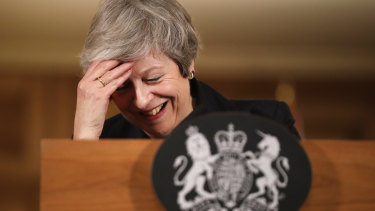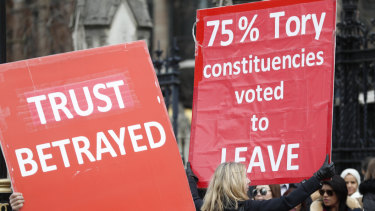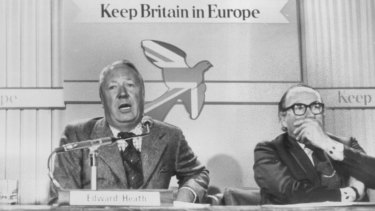Home » World News »
Europe, the killer of British Tory PMs
How will history judge Theresa May, the latest Conservative prime minister brought down by Europe?
Theresa May at a press conference at 10 Downing Street last year.Credit:AP
May was encouraged by advisers to personalise the campaign and capitalise on her apparent popularity. But her "strong and stable" slogan, repeated ad nauseam, never recovered from the manifesto debacle and, indeed, came to parody her challenge.
Ironically, she won a bigger share of the vote than any Tory leader since Margaret Thatcher in 1983 – but lost her majority. She also lost her two closest advisers, which for a Prime Minister who was woefully short of allies in the Commons and with no ideological followers to sustain her was to prove a grievous blow.
What she did have was prodigious stamina, remarkable given her Type 1 diabetes, a condition often exacerbated by stress, and an exceptional sense of her own rectitude. A lesser mortal would have been floored by the election setback but even though she toyed with resigning, she soldiered on.
She told the same 1922 Committee before which she fell on her sword this week that: "I'm the one who got us into this mess and I'm the one who will get us out of it."
Pro-Brexit protesters demonstrate near parliament in London this week.Credit:AP
But if anything she got them in even deeper by the way she negotiated with the EU. The rest of her domestic agenda, set out with such confidence in July 2016, was sidelined while all efforts were expended for a deal that would get through parliament.
However, she lacked some of the requirements for the task, not least clear communication of her intentions, so everyone knew where they stood, or an ability to reach out to others in her party, in parliament or in Europe.
Rather than make Brexit a national event, she turned it into a narrow partisan matter to be argued about among Conservatives, to the exclusion of others and to the great detriment of her own party. Brexit was not meant to be an internal Tory affair, even if David Cameron initially called the referendum to manage divisions in his own party. It was a binary national choice, with many Tories voting to stay and Labour supporters opting to leave. The Brexit process needed a leader capable of bridging the divide, not one intent on widening it.
This concatenation of events, strategy and personality came together to produce the inevitable denouement at Westminster this week. She has reached the end of the road.
Then opposition leader Ted Heath and Labour Home Secretary Roy Jenkins campaign to “Keep Britain in Europe” ahead of the 1975 referendum, in which two-thirds of voters opted to stay in the Common Market. Credit:AP
Vernon Bogdanor, the constitutional historian, argues in a new book that five Conservative prime ministers have been felled in part or in whole by Europe. Harold Macmillan's government never recovered from the French veto on Britain joining Europe's Common Market in 1963. Edward Heath lost the two 1974 elections narrowly, with the Common Market issue playing some part in his demise. The events leading to Margaret Thatcher's downfall in 1990 were triggered by her response to Europe's federal ambitions that resulted in the Maastricht treaty.
This in turn haunted her successor John Major throughout his premiership. Cameron was brought down by a referendum he called to put the issue to bed once and for all. May's fate demonstrates what a forlorn hope that was.
Telegraph, London
Source: Read Full Article





